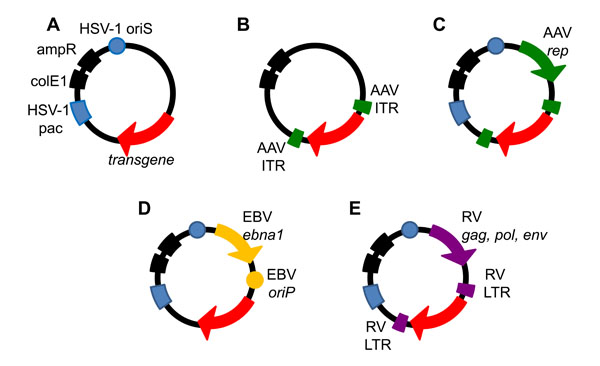Fig. (2) Viral vectors. A) HSV-1 amplicon. The HSV-1 amplicon contains three types of genetic elements: i) sequences from bacteria (colE1 and ampR) that allow plasmid propagation in E. coli; ii) sequences from HSV-1, in particular an origin of DNA replication (ori) and a DNA packaging/cleavage signal (pac), which allow replication and packaging of the amplicon DNA into HSV-1 particles in the presence of HSV-1 helper functions in mammalian cells; and iii) a transgene cassette with the gene of interest. B) Recombinant AAV vector. Recombinant AAV vectors are bacterial plasmids that contain the AAV ITRs flanking a transgene of interest. Replication of the ITR cassette and packaging into AAV particles is achieved by supplying helpervirus functions and the rep and cap genes in cis or trans but outside the ITR cassette. C) HSV/AAV hybrid amplicon. In addition to the HSV-1 amplicon elements, HSV/AAV hybrid amplicon vectors contain the AAV rep gene and a transgene of interest flanked by AAV ITRs. D) HSV/EBV hybrid amplicon. In addition to the HSV-1 amplicon elements, HSV/EBV hybrid amplicon vectors contain the EBV origin of DNA replication (oriP) and the gene encoding EBNA-1 which together can support episomal retention and segregation of the vector in dividing cells. E) HSV/RV hybrid amplicon. In addition to the HSV-1 amplicon elements, HSV/RV hybrid amplicon vectors contain the retrovirus (MoMLV) gag, pol, and env genes, and the RV LTRs flanking a transgene of interest.


